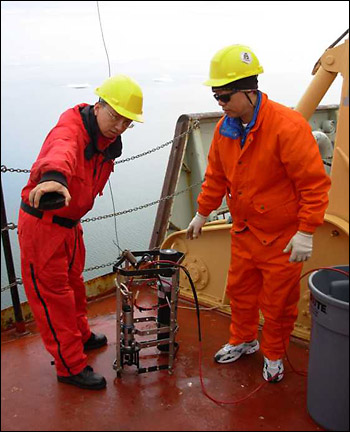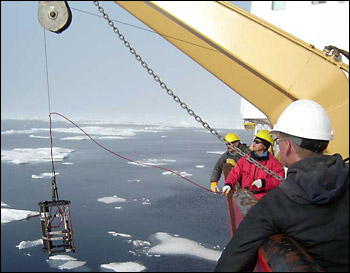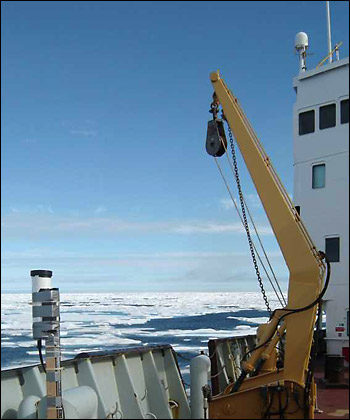Please note: You are viewing
the unstyled version of this website. Either your browser does not support CSS
(cascading style sheets) or it has been disabled. Skip
navigation.
Jinping Zhao (Ocean University of China)August 15, 2006
When the ship is stopped for a CTD station, Jiuxin and Yutian deploy an optical profiler down to 120 m that measures the upward and downward optical fluxes which are used to obtain the optical attenuation coefficient. The instrument (produced by the Biospherical Instruments Inc.) measures the fluxes at 18 wavelengths from 313 to 873 nm with high sensitivity, so as to capture the weak light in deeper water. Another profiling instrument with sensors of temperature, salinity, pressure, and fluorescence is combined with the optical measuring profiler to measure the hydrographic properties, chlorophyll and turbidity. Water samples at 5 m, 20 m and the depth where the maximum amount of chlorophyll is observed, are filtered by different films to measure the intrinsic optical absorptions by various substances in water. In addition, a separate surface optical instrument is mounted to the ship's railing in the air to measure the solar radiance simultaneously with the underwater profiling. So far this cruise, eighteen casts have been conducted by Jiuxin and Yutian, including 4 on this day alone. The results analyzed together with nutrient data obtained by the CTD chemistry group will establish linkages among the physical, optical, chemical, biological processes. The OUC group is dispatched by an Arctic project "Adjustment of thermodynamical structure of Arctic Ocean under the background of global change and its feedback to Arctic climate" funded by the National Nature Science Foundation of China. Last updated: October 7, 2019 | |||||||||||||||||||
Copyright ©2007 Woods Hole Oceanographic Institution, All Rights Reserved, Privacy Policy. | |||||||||||||||||||





